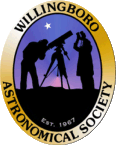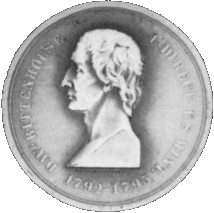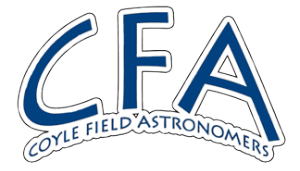The Crescent Moon and Jupiter
May 4, 2014
On the evening of May 4, 2014, the 31% illuminated crescent moon was 8.5° southeast of the planet Jupiter. Between them, the triangle of stars clockwise from the top are Wasat (Delta Gem), Mekbuda (Zeta Gem) and Lambda Geminorum. This picture is a cropped single frame taken at 10:05 pm EDT from Maple Shade, NJ, with a Canon EOS 6D digital SLR camera (on a fixed tripod) and a Canon EF 100 mm f/2.8L Macro IS USM lens. It was exposed 0.6 seconds at f/4, ISO 800. The field is about 14° wide x 6° high. The short, faint protuberance emerging from the upper-left of Jupiter is a row of three Galilean moons, Io, Europa and Ganymede.
C/2012 K1 (PANSTARRS)
April 27, 2014
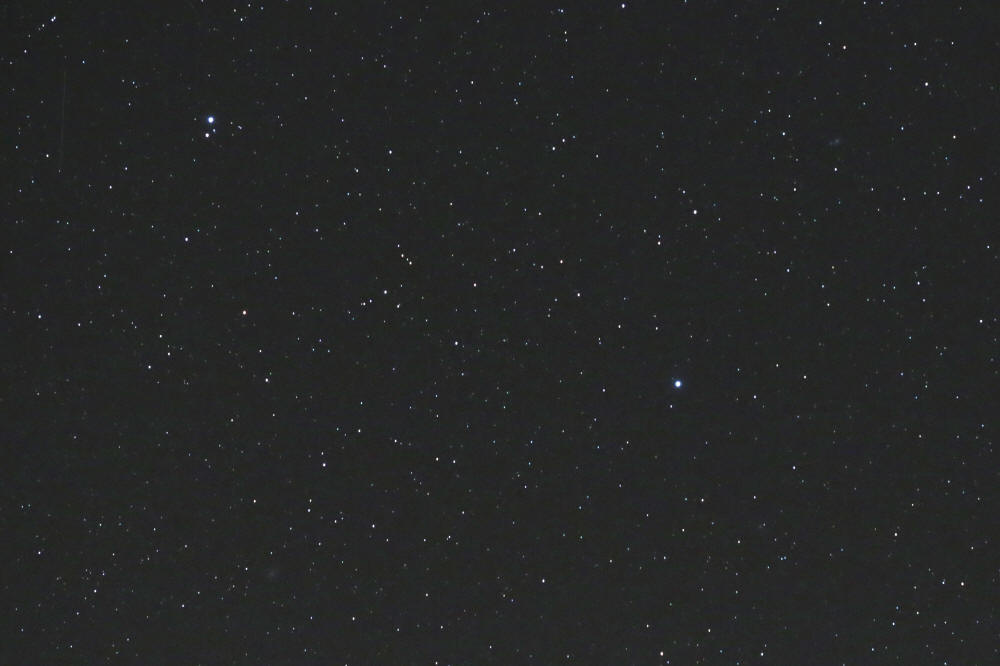
On April 27, 2014, Comet C/2012 K1 (PANSTARRS), around magnitude 9, was captured as a faint smudge about 3.5 arc minutes from the magnitude 9.6 star, SAO 44819, both of which are about 2° from Alkaid (Eta UMa), the star at the end of the Big Dipper's handle. C/2012 K1 may reach magnitude 6 this summer. Also nearby are smudges from galaxies M101 and M51, and in the upper-left, the famous naked-eye double star, Mizar & Alcor (mouseover for labels). This picture is a cropped single frame taken at 9:38 pm EDT from Coyle Field in Woodland Township, NJ, with a Canon EOS 6D digital SLR camera (on a fixed tripod) and a Canon EF 100 mm f/2.8L Macro IS USM lens. It was exposed 6 seconds at f/4, ISO 6400. The field is about 12° wide x 8° high. The close-up images of K1 and M51 below were cropped to the same size (roughly 2° wide × 1.4° high) from the same original file. Here's more of the April 27th session at Coyle Field.
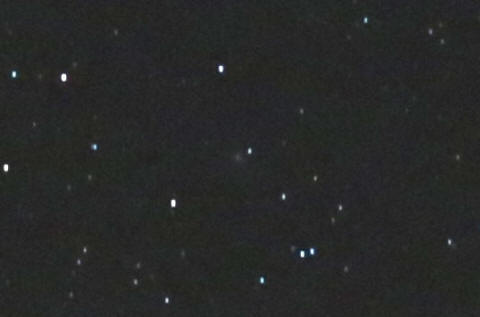 |
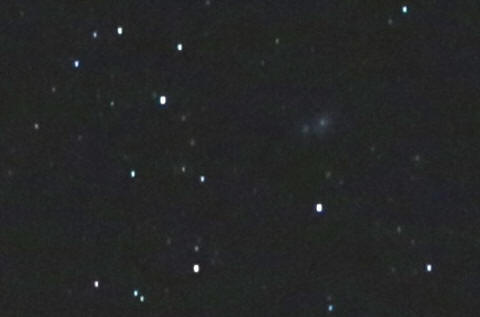 |
| C/2012 K1 (PANSTARRS) at center | M51 above-right of center, NGC 5195 is the left lobe |
Ceres, Vesta and Mars
April 27, 2014
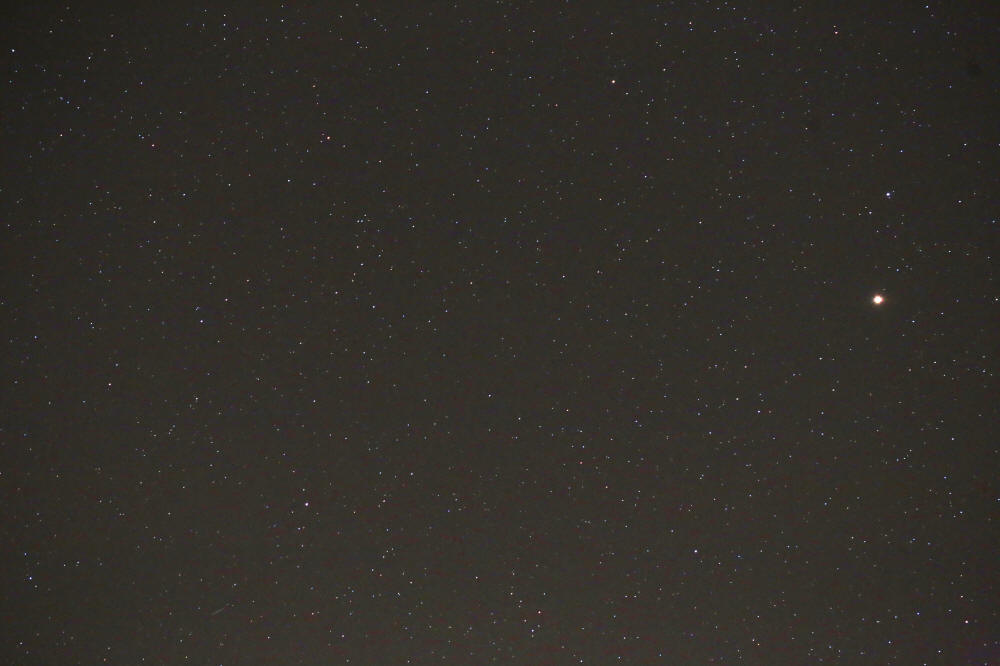
On April 27, 2014, the asteroids (1) Ceres and (4) Vesta were about 2.5° apart in the constellation Virgo, and 14° east-northeast of the planet Mars (mouseover for labels). Ceres and Vesta are bright enough (magnitude 7.1 and 5.9 respectively at the time) to be easy binocular objects; refer to this Sky & Telescope article, which has a nice finder chart. This picture is an uncropped single frame taken at 9:49 pm EDT from Coyle Field in Woodland Township, NJ, with a Canon EOS 6D digital SLR camera (on a fixed tripod) and a Canon EF 100 mm f/2.8L Macro IS USM lens. It was exposed 4 seconds at f/4, ISO 6400. The field is about 20° wide x 14° high.
Lunar Eclipse
April 15, 2014
On April 15, 2014, there was a total lunar eclipse during the early morning hours. However, the weather offered little cooperation for observers in the Delaware Valley. Around 1:30 am EDT in Delran, NJ, I noticed a slight darkening from the penumbral stage in a moderately clear sky with broken clouds. By time I arrived home to Maple Shade, NJ, cloud cover was nearly complete. When this picture was taken at 2:13 am, there was a light sprinkle of rain, but the moon was somewhat visible through a gauzy opening in the clouds. Darkening from the umbra of the earth's shadow is quite apparent at the upper-left of the lunar disc. Taken with a Canon 6D digital SLR camera and a Canon 100 mm f/2.8L macro lens (then subsequently cropped). Exposed 1/30 second at f/4, ISO 3200; handheld, but with stabilization activated. Not the best picture, but it's all I have because when I checked again at 2:30 and 3:00 am, the sky was heavily overcast (then I dozed off).
Crescent Moon over Center City
April 1, 2014
On April 1, 2014, the setting 2.3-day-old crescent moon was heading towards center-city Philadelphia when this picture was captured at 9:23 pm EDT from the Cuthbert Blvd bridge crossing the Cooper River in Cherry Hill, NJ. This single frame was taken with a Canon 6D digital SLR camera and a Canon 70-200 mm f/2.8L zoom lens (on a fixed tripod) set to 200 mm focal length (then lightly cropped). Exposed 1/2 second at f/4, ISO 400. At the time, the moon was 54 hr 28 minutes old, 6.3% illuminated, 3° altitude and 285° azimuth. The previous evening, March 31, 2014, a 1.8% illuminated, 28 hr 40 minute old moon was spotted with 10x42 binoculars at 7:25 pm (2 minutes after sunset) from Delran, NJ, after which it could be located with unaided eyes. On April 1st, the crescent was readily visible with unaided eyes. My thanks to Jerry Lodriguss for reminding me about this young moon, and especially for the reminder about about the juxtaposition with the Philadelphia skyline on April 1st. Here's his excellent image of the scene.
Ceres, Vesta and Mars
March 27, 2014
On March 27, 2014, when they were imaged here, the asteroids (1) Ceres and (4) Vesta were about 2.5° apart in the constellation Virgo, and 13° to 10.5° respectively from the planet Mars (mouseover for labels). Ceres and Vesta are bright enough to be easy binocular objects; refer to this Sky & Telescope article which has a nice finder chart. Also, notice the string of stars descending from Tau Virginis; it's reminiscent of Kemble's Cascade in Camelopardalis. This picture is a single frame taken at 12:35 am EDT from Atsion, NJ, with a Canon EOS 6D digital SLR camera (on a fixed tripod) and a Canon EF 100 mm f/2.8L Macro IS USM lens. It was exposed 6 seconds at f/2.8, ISO 3200. The field of view is about 20° wide x 14° high.
Hospital Room Astronomy
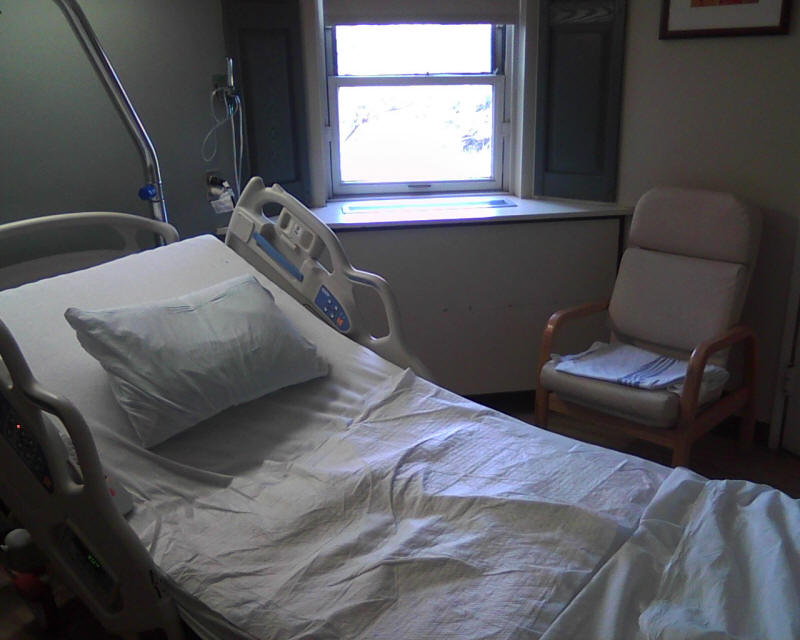
A medical procedure necessitated that I make a several-day stay at Penn-Presbyterian Hospital in Philadelphia, PA, during March 2014. Here's a view of my bed and the single window that was my only access to the sky. It looks out of Cupp Pavillion over the Myrin Circle towards the Scheie Eye Institute. Here's a map of the campus; the room was just to the left of the "C" label. The picture below shows the daytime view out the window (all pictures were taken with an ordinary cell phone, a Pantech Breeze II (P2000), having a native resolution of 1280 x 1024 pixels, cropped to 800 x 640 for this web page).
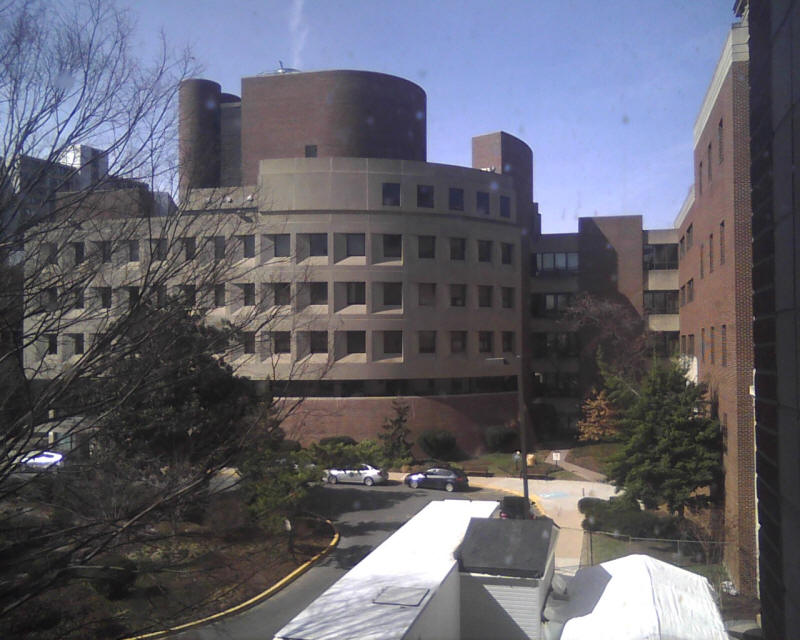
The Scheie Institute is the rounded building straight ahead while the Wright Saunders Building is on the right. Wright Saunders is nearly edge-on from my window, and the wall is essentially parallel with Market Street, which runs east-west. This picture was taken at 11:25 am EDT on March 16, 2014, and since the shadows indicate the sun is to the upper left, I must be facing west. Note the connecting bridge between Scheie and Wright Saunders. It's mostly glazed, but there's a solid brick column in the middle. This bridge is close to being due west of my viewpoint. Looking out the window after dark on Thursday and Saturday nights (March 13 and 15th), I was able to easily see Rigel (in Orion) just above the tree branches in the upper-left of the frame. It took some neck craning to get Betelgeuse, while Bellatrix, Saiph and the belt stars were tougher to see because of the light pollution from the city and the moon, not to mention security lighting illuminating the dirt on the window.
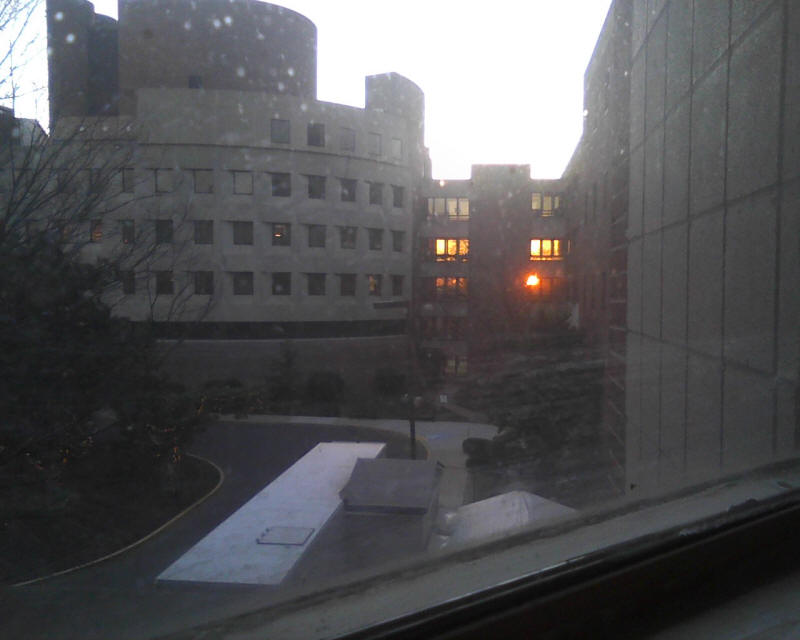
Anyway, what prompted me to use the cell phone camera in the first place was the pretty sunset on Saturday, March 15th. The orange sun was shining through windows of the bridge between Scheie and Wright Saunders. Later in the night (around 2:30 am Sunday, March 16th, actually), I woke up and saw the nearly-full moon through the rails of the bed. In fact, as I lay motionless, I could see the moon slowly creep up on the rail and then disappear behind it as the earth rotated. Full moon was at 1:08 pm EDT on Sunday.
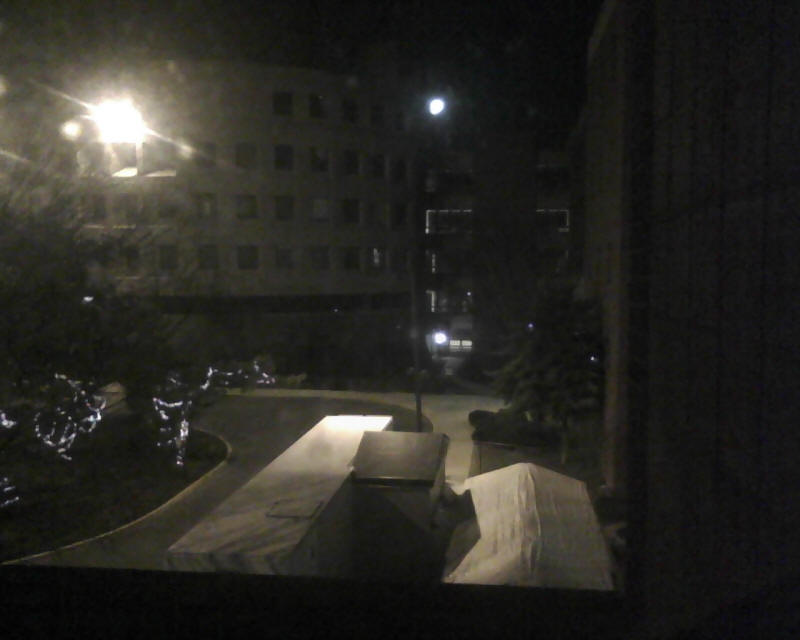
I woke up again at 5:30 am on Sunday, March 16th, and the moon was now just above-left of the tower in the bridge between Scheie and Wright Saunders (the moon is the bright object at the middle near the top of the picture; the other bright light to the left is a security light illuminating the Myrin Circle. Then it struck me, the currently setting moon and the setting sun of the previous evening were nearly in the same place! I'm quite familiar with the rising full moon being opposite the setting sun (since the full moon is at opposition), but far less often do I see the setting sun and the setting full moon on the same night, because (primarily) one infrequently goes out observing at full moon (but the next full moon on April 15th will be an exception because of the total lunar eclipse).
In the summer, at our location of 40° north latitude, the sun sets in the northwest and the full moon rises opposite it in the southeast. In winter, the sun sets in the southwest as the full moon rises in the northeast. But this also means that the summer full moon sets in the southwest and the winter full moon sets in the northwest. Conversely, the summer full moon rises in the southeast and sets in the southwest. So, the setting moon is usually at a different azimuth (oftentimes, much different) than the setting sun that day.
Then I realized this full moon is a bit special because it's close to the vernal equinox, which will be on Thursday, March 20, 2014, at 12:57 pm EDT, when the sun crosses the celestial equator (i.e., the sun's declination will be zero). The equinoxes are the only dates when the sun rises and sets due east and due west respectively. Furthermore, since the full moon will be opposite the sun, it too will be near the celestial equator (actually within about +/-5° because of the tilt of the moon's orbit vs. the ecliptic, which is the sun's path in the sky). So, the full moon will also be rising and setting nearly due east and west like the sun. In fact, at 5:30 am EDT on Sunday, March 16th, the moon's declination was about -4°, so indeed, the moon was largely on the same path as the sun, just a few degrees south of it (more-or-less left of the sun in this view). I suppose I shouldn't have been surprised at them setting in nearly the same place, but it's interesting to actually see the practical effects of what might otherwise be just a geometric concept.
Click here for some older images.
